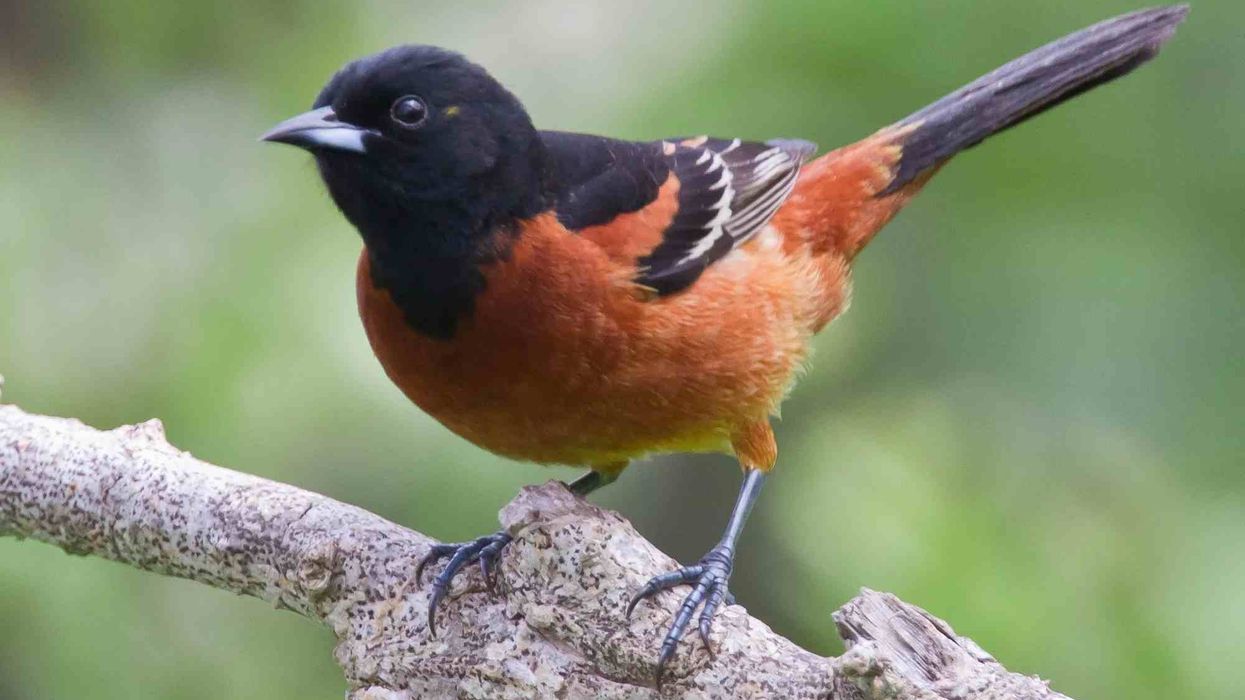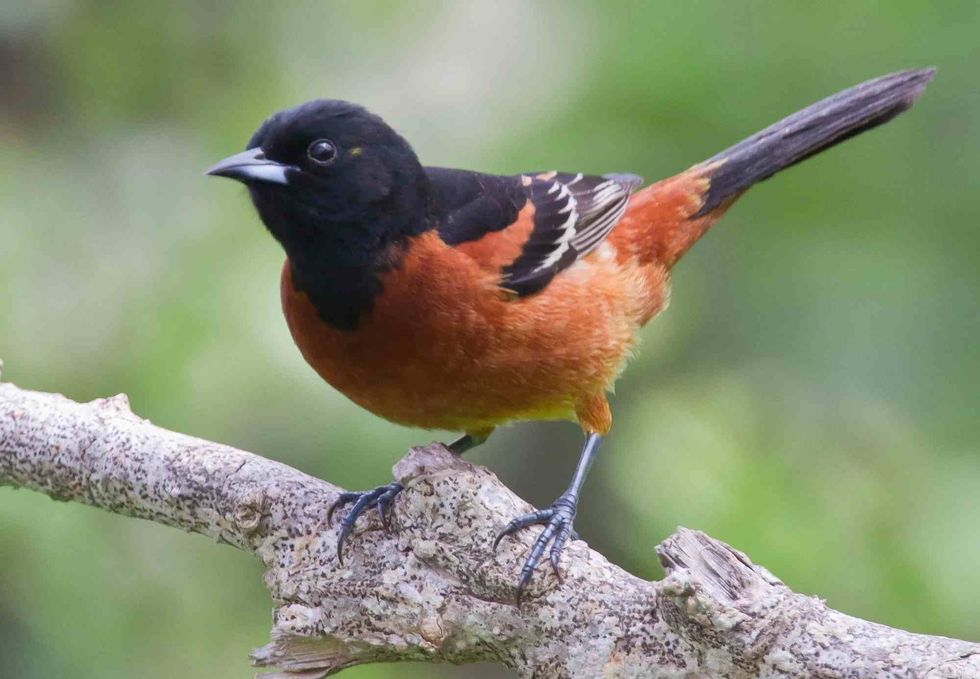The orchard oriole (Icterus spurius) belongs to the order Passeriformes, family Icteridae. It is the smallest oriole bird found in North America.
These migratory birds tend to breed in the US, Canada, and Mexico. They have two migrations, one in spring and the other in the fall. They leave for their wintering grounds as early as July and settle in Central America, the coasts of Mexico, and northern South America.
These birds prefer habitats with, or near, water sources and areas that have scattered trees in abundance. They nest in loose colonies and live close to each other and other related or unrelated species.
Their diet depends on the seasonal availability of food and protein requirements. Usually, they can be seen feeding on nectar, fruits, insects, and other small arthropods.
Read on to know more about its physical appearance, range of habitat, and other interesting facts about the orchard oriole. If you like reading about these North American birds, do consider reading our other articles on the hummingbird and the hooded oriole.
Orchard Oriole Interesting Facts
What type of animal is an orchard oriole?
An orchard oriole is a songbird. It is the smallest among the oriole birds of North America.
What class of animal does an orchard oriole belong to?
Orchard orioles belong to the class Aves of the Kingdom Animalia. It is of the order Passeriformes, family Icteridae.
How many orchard orioles are there in the world?
While an exact estimate is not available, these North American birds are abundantly found in eastern areas. However, they have faced a decline in Central America.
Where does an orchard oriole live?
The orchard oriole is endemic to both Nearctic and Neotropical regions. During the breeding season, the bird species range from Canada to the states in the north of the US. Specifically, they can be found in southern Ontario, New York, Maine, and along the east coast.
It also covers the western states of Montana, Colorado, Texas, and Oklahoma. This range extends into central Mexico and to several South American countries. Following its fall migration, the birds settle in their wintering grounds in Columbia and Venezuela.
What is an orchard oriole's habitat?
Orchard orioles are highly adaptable and can be found in a range of habitats. Generally, it prefers open woodlands along river edges or floodplains and marshes. During the summer they inhabit arid or semiarid lands in Texas and wetlands in Louisiana.
After migration, these birds winter in forests where scattered trees are laden with flowers and fruits. They leave for their wintering grounds as early as mid-July.
The birds are not sensitive to anthropogenic activities, therefore their nests can be found in areas adjacent to human settlements.
Who does the orchard oriole live with?
This bird is generally social and tends to form loosely tethered colonies during its breeding season. Each bird tends to build its nest in close proximately to each other and birds of other species. This strategy helps in warding off predators.
How long does an orchard oriole live?
They may live up to 10 years in the wild.
How do they reproduce?
Orchard orioles are monogamous birds. The adult males find their mates after the spring migration in March and April.
After selecting mates and settling on the breeding grounds, the females start building nests shaped like a cup and then proceed to lay two to seven eggs at a time. The incubation period is 12-14 days, after which the chicks are born. Both males and females take care of the chicks and protect the nest.
The young birds fledge after 11-14 days. The females and young stay behind in the breeding habitats while the males embark on their fall migration.
What is their conservation status?
According to the IUCN Red List, this species' population is stable and categorized as of Least Concern. At present, there are no special conservation plans dedicated to this bird.
Orchard Oriole Fun Facts
What does an orchard oriole look like?

The orchard oriole (Icterus spurius) is the smallest among the orioles species of North America. Adult male and female birds inherit different physical features. A male orchard oriole has a black head and tail, small beady eyes, and a long sharp bill. It has rusty-colored feathers with traces of yellow on the underside.
Whereas the female bird has a pale lime-colored body with brown and white wing bars. An immature male orchard oriole resembles a female, except for its black head. These birds have blackish-blue or slate-colored feet.
How cute are they?
They are extremely exotic-looking birds. With their beautiful plumage and relatively small size, they are very cute to look at.
How do they communicate?
Only the males are known to sing, otherwise, the birds use monotonous calls. Each bird develops its species-specific bird song over the years, as it grows. The short song begins with two high-pitched notes, in the beginning, ending with lower-pitched phrases. Other calls are made up of sounds like chuck and chatter.
These birds also use whistles and songs to communicate with each other. They are known to respond to alarm calls by other species as well.
How big is an orchard oriole?
This species of oriole is the smallest bird found in North America. It is almost two and a half times smaller than a crow.
How fast can an orchard oriole fly?
Orioles are pretty agile. Their wingspan is about 9.8 in (25 cm). Their flight is characterized as light. They display rapid wingbeats and hover over shrubbery while foraging. The exact speed of their flight is not known.
How much does an orchard oriole weigh?
Orchard orioles are small birds that weigh around 0.6-0.9 oz (16-25 g).
What are the male and female names of the species?
There are no distinct names for the different sexes of this species.
What would you call a baby orchard oriole?
A baby orchard oriole is called a chick.
What do they eat?
Orchard orioles generally eat insects and spiders. Their diet also includes other arthropods, fruits, and nectar. Their long bill is utilized to pick out wasps, caterpillars, beetles, and bugs from the foliage. They even feed on the nectar from hummingbird feeders. Their diet shifts to pollen and fruit during their stay in Central America.
Are they dangerous?
Orioles are insectivorous by nature. Other than small insects and arthropods, they do not harm other creatures. Orioles are not generally aggressive by nature. They defend their nests during the breeding season and give calls to alarm their fellows.
Confusion surrounds their behavior with hummingbirds. They are not known to kill or harm hummingbirds, however, they do drink nectar from the feeders left for the hummingbirds.
Would they make a good pet?
No, sadly these birds cannot be kept as pets. Even though they are extremely beautiful creatures. This species requires a certain habitat for its nest placement and other activities. These demands cannot be met in a household.
Did you know...
Orchard orioles are diurnal except for their spring and fall migrations, during which they have been observed to be nocturnal.
Orioles signify different things in different cultures. For example, to Native Americans, orioles symbolize humility and diligence. In Asian cultures, orioles symbolize status, passion, and faith. Orioles are also at times viewed as a good omen and a symbol of putting the worst behind us.
People have often been seen putting up feeders for these birds. The best location to put up an oriole feeder is in shady areas, away from other feeders. This ensures the freshness of nectar and other feed. It also ensures that these birds do not get attracted to other feeders.
Foods that can be offered to orioles also include grape jelly or other jellies of different flavors.
What's the difference between a Baltimore oriole and an orchard oriole?
Baltimore orioles are slightly larger at 6.7-7.5 in (17-19 cm) compared to orchard orioles. Adult male birds also differ in appearance.
An adult male Baltimore oriole has flame-orange and black plumage with a black head and white bars on its wings, whereas the orchard oriole has chestnut plumage. The adult females do, however, resemble the orchard orioles with their yellow-green bodies. Key factors to look out for are pointy bills and brown wings.
Do Orioles nest in pine trees?
Orioles build their nests on a range of trees such as ash, willow, elm, and even pine trees.
Here at Kidadl, we have carefully created lots of interesting family-friendly animal facts for everyone to discover! Learn more about some other birds including the tawny eagle and the common blackbird.
You can even occupy yourself at home by drawing one of our orchard oriole coloring pages.










